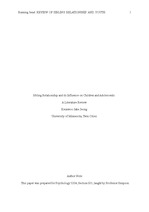· Bank, L., Burraston, B., & Snyder, J. (2004). Sibling conflict and ineffective parenting as
· predictors of adolescent boys' antisocial behavior and peer difficulties: Additive and interactional effects. Journal of Research on Adolescence, 14(1), 99-125.
· Bowes, L., Wolke, D., Joinson, C., Lereya, S. T., & Lewis, G. (2014). Sibling bullying and risk
· of depression, anxiety, and self-Harm: A prospective cohort study. Pediatrics, 134(4). doi:1032-1039
· Branje, S. J. T., Lieshout, C. F. M., Aken, M. A. G., & Haselager, G. J. T. (2004). Perceived
· support in sibling relationships and adolescent adjustment. Journal of Child Psychology and Psychiatry, 45(8), 1385-1396.
· Buist, K. L., & Vermande, M. (2014). Sibling relationship patterns and their associations with
· child competence and problem behavior. Journal of Family Psychology, 28(4), 529-537.
· Buist, K. L., Deković, M., & Prinzie, P. (2013). Sibling relationship quality and
· psychopathology of children and adolescents: A meta-analysis. Clinical Psychology Review, 33, 97-106.
· Criss, M. M., & Shaw, D. S. (2005). Sibling relationships as contexts for delinquency training
· in low-income families. Journal of Family Psychology, 19(4), 592-600.
· Fletcher, G., Simpson, J. A., Campbell, L., & Overall, N. C. (2013). The science of intimate
· relationships (1st ed., pp. 92-93). Chichester, West Sussex: Wiley-Blackwell.
· Gamble, W. C., Yu, J. J., & Kuehn, E. D. (2011). Adolescent sibling relationship quality and
· adjustment: Sibling trustworthiness and modeling, as factors directly and indirectly Influencing these associations. Social Development, 20(3), 605-623.
· Gass, K., Jenkins, J., & Dunn, J. (2007). Are sibling relationships protective? A longitudinal
· study. Journal of Child Psychology and Psychiatry, 48(2), 167-175.
· Keeton, C. P., Teetsel, R. N., Dull, N. M., & Ginsburg, G. S. (2015). Parent psychopathology
· and children’s psychological health: Moderation by sibling relationship dimensions. Journal of Abnormal Child Psychology, 43, 1333-1342.
· Kim, J., McHale, S. M., Crouter, A. C., & Osgood, D. W. (2007). Longitudinal linkages
· between sibling relationships and adjustment from middle childhood through adolescence. Developmental Psychology, 43(4), 960-973.
· Kitzmann, K. M., Cohen, R., & Lockwood, R. L. (2002). Are only children missing out?
· Comparison of the peer-related social competence of only children and siblings. Journal of Social and Personal Relationships, 19(3), 299-316.
· Kopak, A. M., Chen, A. C., Haas, S. A., & Gillmore, M. R. (2012). The importance of family
· factors to protect against substance use related problems among Mexican heritage and White youth. Drug and Alcohol Dependence, 123, 34-41.
· Lamis, D. A., & Jahn, D. R. (2013). Parent–child conflict and suicide rumination in college
· students: The mediating roles of depressive symptoms and anxiety sensitivity. Journal of American College Health, 61(2), 106-113.
· Lockwood, R. L., Kitzmann, K. M., & Cohen, R. (2001). The impact of sibling warmth and
· conflict on children's social competence with peers. Child Study Journal, 31(1), 47-69.
· Mendelson, M. J., Aboud, F. E., & Lanthier, R. P. (1994). Kindergartners' relationships with
· siblings, peers, and friends. Merrill-Palmer Quarterly, 40(3), 416-435.
· Morgan, J. K., Shaw, D. S., & Olino, T. M. (2012). Differential susceptibility effects: The
· interaction of negative emotionality and sibling relationship quality on childhood internalizing problems and social skills. Journal of Abnormal Child Psychology, 40, 885-899.

